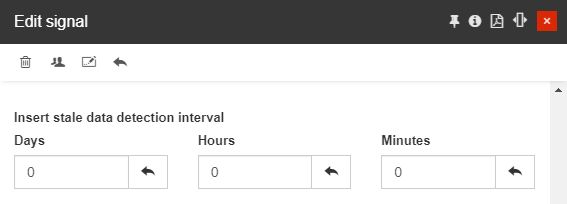The Signal Stale Data Detection feature
Check out this article and learn more details about the Stale Data Detection feature of a Signal, describing the most common situations when enabling it is a plus for you.
Within the i4connected system, the Stale Data Detection step checks if a counter signal does not change its value over a defined period of time and triggers an alarm if this happens. The purpose of this feature is to detect broken counters which do not report value changes.
The Stale Data Detection feature is defined in Add/Edit signal panel, within the Advanced settings area.

The Insert stale data detection interval settings
By inserting a stale data detection interval, the user defines the minimum interval of time to wait before triggering an alarm, if new values are not registered for that Signal.
Warning
If the Signal's parent Device has its alarms suppressed, no alarms will be triggered stale data are detected.
Note
By default, alarms of type "Stale data" have no priority associated. However, if the source Device has a priority set as Overwrite event priority, that priority will be used for all the alarms triggered in the context of that Device, including the 'Stale data" alarms.
The 'Stale data" alarm, having the parent device as a source, will be automatically closed if the signal value changes.
Tip
For a better understanding, let's discuss the following example:
We have set the stale data detection timer, for a Counter Signal that receives new values every 5 minutes. As long as a new value is received no alarm will be triggered.
If the Counter Signal receives a new value, equal to the previous one, and this value is persisted during the selected stale data detection interval, a new alarm will be triggered.

The alarm will be automatically closed if the Signal counter is changed.
The "Stale data" alarms can be picked up by the i4messenger component, to enable the delivery of notifications to a list of users belonging to a Response Team, considering custom escalation policies.
Tip
For more details about the i4messenger addon, please visit the dedicated articles here.